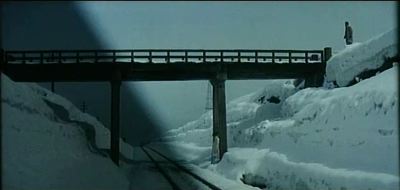I recently watched this film “Tokyo Drifter” out of my Netflix queue. It is a Yakuza yarn that has many fascinating filmic attributes, of course it being a Criterion issue, there are bound to be some cinematographically interesting elements.
Most notable of the wide range of visual styles used include an opening sequence that looks like it was shot on high contrast black and white titling film stock, then there are the glimmers of the disco that the henchmen are always wandering through to get to the big cheeses. This crazed, psychadelically inspired Tokyo dance room always keep me wanting more, more, more. Of course I would not want to forget the full on Western bar room brawl where everything and everyone gets demolished. Then there are the multiple moments when the lead dude, a reformed Yakuza drifter named Tetsu, breaks into full song while meandering the wastelands of Japan singing and re-signing a song that sounds almost exactly like “A Town Without Pity†by Gene Pitney:
When you’re young and so in love as we
And bewildered by the world we see
Why do people hurt us so
Only those in love would know
What a town without pity can do
If we stop to gaze upon a star
People talk about how bad we are
Ours is not an easy age
We’re like tigers in a cage
What a town without pity can do
The young have problems, many problems
We need an understanding heart
Why don’t they help us, try and help us
Before this clay and granite planet falls apart
Take these eager lips and hold me fast
I’m afraid this kind of joy can’t last
How can we keep love alive
How can anything survive
When these little minds tear you in two
What a town without pity can do
How can we keep love alive
How can anything survive
When these little minds tear you in two
What a town without pity can do
No, it isn’t very pretty what a town without pity
But it was not until this sequence came along that I realized I had to share this film. Out of nowhere, there is a scene that looks like a camera test for a new set of graduated filters. Graduated filters are a common cinemagraphic tool for controlling lights levels without changing color. There is a great description on the Wiki page. Trail and error has helped cameramen worldwide learn that there are a number off rules, or no-nos, when using grad filters. Most are designed to not give away the fact that you are indeed doing anything to enhance or alter the shot. Things like zooming, which forces the grad filter line to move unaturally within the frame, or tilting the camera thus altering the area that has been graduated and again giving away the gag. Probably the most common no-no is using too much graduation, where the viewer clearly sees the line of the filter and the element of reality is crossed.
Well, there is also another long held cinemtagraphic rule of thumb, and that is when you go for an effect or a “lookâ€, don’t pussy foot around it, if you are going to go for it, then go for it.
Well, this sequence really goes for it with gusto, breaking every rule of graduated filtering I can think of and then some. And the coolest thing is that there is not a grad to be see in the rest of the movie, just this sequence.
Click on the frame below and the quicktime will show up in a separate window.
Enjoy.

Here is a related page on everything you ever wanted to know about polarization of lightwaves.